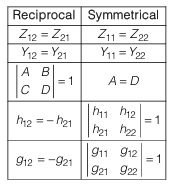Two Port Network
INTRODUCTION
A pair of terminals through which a current may enter or leave a network is known as a port. Most of the circuits we have dealt with so far are two-terminal or one-port circuits, represented in fig. (a). We have considered the voltage across or current through a single pair of terminals-such as the two terminals of a resistor, a capacitor, or an inductor. We have also studied four-terminal or two-port circuit involving op-amps, transistors and transformer as shown in fig. (b). Thus, we can say that a two-port network is an electrical network with separate ports for input and output.
In general, a network may have n ports. In this chapter, we are mainly concerned with two-port networks (or simply, two ports).
Network Parameters
In two port network four variables are use (i.e., V1, V2, I1, I2) out of four variable, we can chose two variable in six different way (4C2), and hence we have six sets of two-port.
- Z-parameters (Impedance parameters)
- Y-parameters (Admittance parameters)
- ABCD parameters (Transmission parameters)
- A′ B′ C′ D′ parameters (Inverse transmission parameters)
- h-parameters (Hybrid parameters)
- g-parameters (Inverse hybrid parameters)
Impedance or Z-parameters (Open circuit parameters)
V1 = Z11I1 + Z12I2 and V2 = Z21I1 + Z22I2
Admittance or Y-parameters (Short circuit parameters)
I1 = Y11V1 + Y12V2 and I2 = Y21V1 + Y22V1
h-parameters (Hybrid parameters)
V1 = h11I1 + h12V2 and I2 = h21I1 + h22V2
g-parameters (Inverse hybrid parameters)
I1 = g11V1 + g12I2 and V2 = g21V1 + g22I2
ABCD parameters (Transmission parameters)
V1 = AV2 – BI2 and I1 = CV2 – DI2
Conditions for a network to be symmetrical and reciprocal


